|
|
William R. Carr
| Since this site was launched, and this "The Search for Lines"
page written, some significant progress has been made in the search for the
"Lines" and the plans of the Sea Witch. The search is still ongoing,
but significant progress has been made.
FEBRUARY 2010 WINDFALL: We finally have a genuine WILBO lines drawing and table of offsets! See updates at the bottom of this page, and the Sea Witch Plans Page. |
Like many romantic boat lover, I've admired Hugh Angelman's Sea
Witch since I first set eyes on her picture. In fact, I've had a fifty
year, and on-going, love affair with the image. My dad had discovered
her in The Rudder Treasury, back in 1953, and he fell in love with her.
I inherited that love at the age of eleven. My dad, who was hoping to build a
boat at that time, wrote for information
and got the study plans (1953 Wilbo Letter). At $300.00 for a full set of building plans, however,
he figured he'd wait until they could be purchased a little cheaper. The situation
got worse. My dad was laid off of his job and his boat building dream went the
way of most dreams. Next time I checked, in 1961 (1961
Letter), they were twice as much! Now
that I am retired from the sea, and am considering building a boat as a
retirement hobby, Sea Witch plans are hard to come by. (But some bits and pieces
have been surfacing since this web site first appeared.)
During the intervening fifty years, one of my hobbies has been yacht
designing – that is, designing my own "dream boat." And, though
there were many variations, Sea Witch has not
only been the inspiration, but very much evident in every design
I've cobbled together. One was even a 52 Foot Trading Ketch
based on the appearance of Sea Witch. Though I had both the original and updated
profile study plans shown below, I could never know for sure whether I had her hull
shape correct.
I got a glimpse of the plans for Sea Witch in 1965 when I had the brief opportunity to call on an American who was building boats on a small island in Subic Bay in the Philippines. He had a tracing of the plans. I remember being rather shocked at the lines at the time. Familiar with many modern yacht designs, I had expected to see the standard graceful hourglass shaped hull, with a smooth transition between the underbody all along the garboard and keel. But the lines I saw weren't like that at all, and looked very peculiar to me. The mid-forebody sections resembled parabolic curves. I was a little incredulous and somewhat disappointed. In spite of all the nautical tradition that I admired in the Sea Witch above the waterline, I hadn't expected Sea Witch to be quite so "traditional" right down to the keel! From my still somewhat uninformed perspective, she looked more like a dugout canoe to me than a yacht.
The forebody comparisons below will perhaps explain. William W. Atkins was one of the preeminent yacht designers of the early 1900s, and had produced many of the boats that I admired, including the famous double-ended cutter, Thistle. In about 1936 he designed the gaff-rigged cutter "Fore & Aft," which was even more traditionally rigged than the Sea Witch – complete with top mast, headsail, deadeyes, and an extra long bowsprit. But, like most yachts being designed at that time, all of his hulls were of the classic hourglass shape with gracefully hollowed garboards – an innovation intended to reduce "wetted surface area" and thus lessen the friction of the underbody as it passed through the water. Though the effective reduction of wetted surface was marginal at best, and of little concern in cruising designs, it produces the pleasing curves of underbody design that have more or less become standard in modern displacement designs. So the lines of the Sea Witch "just didn't look right" to me.
|
|
 Note the similarity between this "very traditional" hull and the forebody of the 1937 Sea Witch lines above. |
Of course, a quick review of Howard Chapelle's The History of American Sailing Ships reveals that many of the fastest classes of 18th and 19th century ships, including privateers, slavers, and revenue cutters, also had a similar midship section, and the midship section of famous schooner yacht America (1851), as well as several later fast pilot vessels and fishing schooners had a similar shape.
Unfortunately, I never got another chance to visit Subic Bay and see the plans again (which was a double tragedy, since I was also enamored with the ladies of Olongapo), and though I visited other Far East boatyards that had built Sea Witches, including Cheoy Lee in Hong Kong, I never had another chance to see a set of plans.
Displeased with some amateur built boats calling themselves "Sea Witches," Hugh Angelman finally decided he would no longer make the plans available to amateur builders. Apparently a few home-builds were giving the design a bad image. The plans became unavailable to anybody other than professional builders.
In April of 1996 I belatedly wrote to Charles Davies again to see if Sea Witch plans might still be available at all. I had written to him at the address given me by Woodenboat magazine a couple of years earlier, but my letter was returned undelivered. When I read Robby Coleman and Thomas Skahill's article in WoodenBoat No. 147 (March/April 1999), I learned that Charles Davies passed away in July of 1998, only two years after I wrote.
I had no idea where plans for the Sea Witch might be obtained,
and only as the result of this web site have a few bits and pieces of the plans
been surfacing. In fact, it was a Sea Witch owner
(Stephen Carlson, owner of the Sea Quest), who contacted me hoping I had a copy
of the plans that lit the spark that resulted in this web site. Stephen knew Hugh Angelman's great-grandson and Charles Davies' son, and apparently
even they did not know where to find a copy of the plans. It was hoped this web site
would be able to uncover some.
A very small-scale lines drawing finally appeared in the Wooden Boat
No. 147 article. It was a redrawn version of the design dated 1937 – but there has been some significant changes since then. The Sea Witch went
from an 11 ton ketch to a 13 ton ketch – and from 35 feet to 36 feet in length
on deck. But, at long last,
I had the basic hull form which corresponded with my memory of the lines I had
seen at Subic Bay. All I had to do, I thought, was combine the updated
profile with the lines, and presto, I'd have at least a close
approximation of the Sea Witch. But it wasn't quite all that simple and
ambiguities remained.
Below the three distinct evolutions the Sea Witch hull are compared; the first being from the 1937 lines drawing that appeared in Wooden Boat.
The second lines illustration shows an evolution that probably took place just
after Hugh Angelman built the first Sea Witches in 1938-41 – producing the 11
ton, 35 foot, Sea Witch and Sea Rover. The third drawing shows the changes made
to the keel circa 1959-60, and most boats professionally built after that date
were built with the new underbody configuration (producing a 13 ton, 36 footer).
|
|
This lines drawing, dated 1937, appeared in the Mar/Apr 1999 edition of WoodenBoat magazine (No. 147), as redrawn by R. D. Kalajian (of Wilmington Boat Works), and may be the only lines ever publicly published for the Sea Witch. Note the long, relatively straight run of the keel and the rabbet line here. These lines show a very "traditional" keel and sharp forefoot. There are several subtle, and some radical, differences between this and both versions below - most notably in the keel profile and rabbet line. (Click here to see an enlargement) |
| The second drawing shows the 1945 lines of post Sea Witch and Sea Rover Wilbos (as reconstructed from the main construction plan and table of offsets). It is believed that this is the shape of all Sea Witches built at Wilbo after Sea Witch and Sea Rover, except for the Golden Hind, built in 1959. The 1937 lines produced a vessel of only 11 tons, whereas the the 1945 plans are for a 13 ton boat. As can be seen, the rabbet line and keel profile had been changed considerably. The Sea Witch is deeper bodied than shown on the 1937 lines. Note also that the rabbet line at the stem is almost vertical at the level of the bowsprit. This drawing also includes the double bowsprit. | |
| The third drawing, reproduced from a lines drawing of the Sea Mist, reflects the modifications made to the underbody profile about 1959 or 1960 (we find that it was probably 1956, and we know that the last Sea Witch built at Wilbo [the Golden Hind in 1959], was built to these lines), pulling the forefoot in slightly, deepening the keel amidships, and lessening the drag of the keel by leveling out the the aft run. The run of the rabbet line was again modified considerably. The stem was slightly lengthened. This refinement made the 35' Sea Witch into a 36' Sea Witch. |
Angelman may have originally conceived the Sea Witch as an almost complete reversion to tradition. The 1937 lines appear to be designed to carry a much larger percentage of ballast inside. The keel is shown on the drawing as rather broad sided (in depth), but relatively "thin" (about 6 inches) – probably too thin to accommodate 5,500 pounds of lead. "Modern" Sea Witches have a 7-1/2 inch thick keel, and carry about 5,500 pounds of lead outside (in the keel), with an additional 1,500 pounds inside for trim purposes. Their displacement (at 26,068 pounds) is 4,168 pounds heavier than the 21,900 pound displacement given in the 1937 lines. Thus, it would appear that the 1937 design would have required very little outside ballast. Of course, there is the distinct possibility that the original Sea Witch was built from the 1937 lines. The only reason I suspect this possibility is that the Sea Witch is listed in the Wooden Boat Directory as having a displacement of 11 tons.
Hull Form Photos of the Sea Quest undergoing restoration work |
|
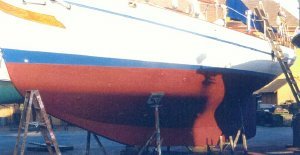 Port side of the Sea Quest hull from fore and aft perspectives. Note the distinct rabbet line in run of mid-body, which disappears near the ends. |
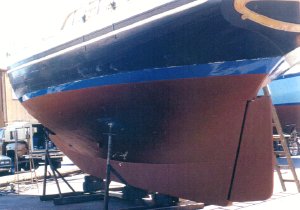 |
|
|
The view at left gives a pretty good
indication of the shape of the midship section, showing little or no
hollowing of the garboard amidships – a midship section with almost a straight
run from under the turn of the bilge to where the hull meets
the keel. There is almost no hollow in the garboard, in the midship section. As seen in the two photos above, there is a very smooth transition from planking to keel timber only toward the very ends of the hull underbody. Yet the appearance is very aesthetic. Photos contributed by Stephen Carlson, owner of the Sea Quest. |
July 2007 update: Having heard from Hank Whittier, current owner of the Sea Witch, we are now able to make a side by side comparison of the original Sea Witch, and the Hong Kong built Sea Quest. Now we can finally see, beyond a shadow of a doubt, that the Sea Witch, and probably the Sea Rover, were built to the 1937 lines, though we still do not have any hull shots of the later WILBOs which conform to the 1945 drawings. Hank says his papers confirm that the calculated displacement of his boat is was 21,900 lbs. Below are similar side by side shots with Sea Witch on the left and Sea Quest on the right.
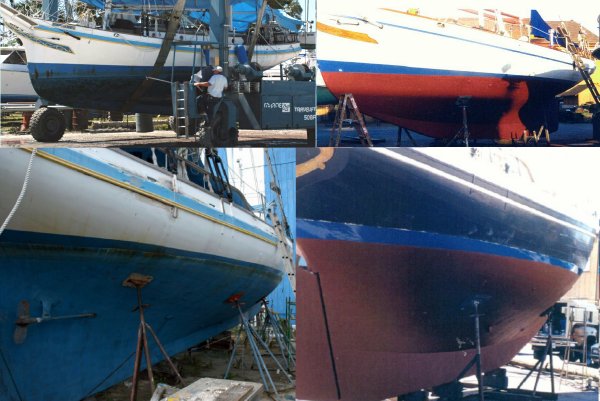 Note the sharper forefoot of the Sea Witch (upper left) and the more gradually deepening keel of it's keel forward. The long straight run of the Sea Witch keel and rabbet line are evident in the lower pictures, making a very marked difference between the two hulls. Left is a very tradition keel, and right is the hull of a modern yacht. There was a subtle change in the keel design after Sea Witch was built, which is reflected in the 1945 study plans and other drawings, and the later Wilbo Sea Witches were probably built to the 1945 lines. The lower Sea Quest hull photo is reversed for comparison, so the propeller, which should be showing in the starboard view, is not seen. Final changes to the lines appear to have been made in 1956 and the Golden Hind (last SW built at WILBO in 1959), and all subsequent Sea Witches built in Hong Kong and elsewhere were probably built to these lines. |
There was a subtle change in the shape of the transom between Sea Witch and Sea Bell, which was the third Wilbo Sea Witch built, which can be seen in the comparison below. This reflects another change between the 1937 and 1945 hull design. The lines were redrawn again in 1956 reflecting the final hull and keel configuration. The Golden Hind was built to them in 1959 at WILBO, and it is believed that all subsequent Sea Witches, built in Hong Kong and elsewhere, were built to these lines.
Though taken from different perspectives, the difference in the shape of the transom between Sea Belle and Sea Witch can readily be seen in the above photos. The Sea Belle's transom has a longer reverse curve as it approaches the center line. It would be a difficult call to choose which is the most attractive, but I vote for Sea Belle.
Apparently Hugh Angelman and Charles Davies did a pretty good job of preventing unauthorized plans of the Sea Witch from circulating. Several of the boatyards that built Sea Witches, including Wilmington Boat Works, no longer exist. Stephen Carlson tells me that Cheoy Lee experienced a fire in which many plans, including those of Sea Witch, went up in smoke. American Marine, Ltd., of Hong Kong, that built more Sea Witches than any other yard, abandoned both sailboats and wood and is now a large Singapore based corporation concentrating on Grand Banks style power yachts.
The suggestions to make some rather radical alterations to the stem, keel, and underbody were Charles Davies' primary contribution to the design. Davies was probably responsible for making Sea Witch into something closer to a modern yacht hull below the water line and is thus the father of the "modern" Sea Witch.
Of course, there is the added factor (to quote Doug Templin, in Peter Bohr's article "A Seawitch Casts Its Spell," in the Feb. 1989 issue of SEA) "Nearly every Seawitch is slightly different, depending on who did the lofting and the building." The very finer points of character of the hull is dependent on accurate lofting and building. And it is at the lofting stage when any inaccuracies in the drawn lines and table of offsets reveal themselves. When such discrepancies crop up, it becomes a matter of judgment to the loftsman and builder just how to resolve them.
The drawing below indicates the changes in the lines between 1937 and
1956, originally based on the hull form photographs shown above, and since confirmed by the lines
of the Golden Hind and Sea Mist, construction drawing and offsets of "Sea Witch and Sea Rover"
which have surfaced. The slight lengthening of
the stem above the waterline is shown by the blue keel, stem, and rabbet line of
the 1937 profile.
|
1937 LINES SUPERIMPOSED ON
1961 STUDY PLAN PROFILE |
Below we take a closer look at the evolution of the Sea Witch bow, first with the 1937 lines and later study plans, and then with some Sea Witch photographs.
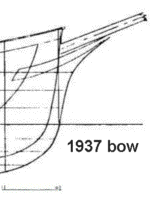 |
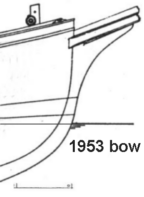 |
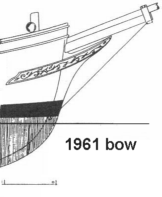 |
| Here, in the 1937 bow, we see a very upright rabbet line with an almost straight run above the waterline and a fairly sharp forefoot. Then (in 1953 [1945 lines]), the forefoot has been cut back and the rabbet line above the waterline re-curves to nearly vertical. The 1961 bow shows that the forefoot was again slightly pulled in and up, and the rabbet given a decided forward slant which extends the bow a few inches forward at deck level, producing the more streamlined "modern," post-Wilbo, Sea Witches (at least in the professionally built ones). | ||
 |
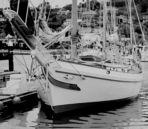 |
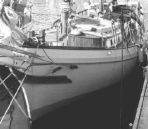 |
| Above is a comparison of the Sea Witch, Sea Quest, and Lualan illustrating the change from a very bluff, upright, stem to the more forward reaching stem of later Sea Witches. This change was probably made in an attempt to make the decks a little dryer in choppy head seas as well as accommodate a slight cutback in the relatively sharp forefoot of the Sea Witch and Sea Rover below the waterline. I fear an arty element of Sea Witch's bluff bow (a certain subtle quaint "tubbiness" that many may not noticed or appreciate), was lost with this slight streamlining of the design. In spite of this streamlining of the bow, the entry at the waterline appears slightly sharper on the Sea Witch than on the later models. Unfortunately, since the perspectives of the photographs vary slightly, it is impossible to illustrate it exactly. The photos below may help illustrate the slight lengthening of the stem. | ||
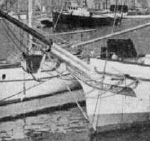 |
|
|
| At left above is the bow of the Sea Rover. The center photo is a similar perspective of the bow of the Sea Quest. The angle of the view of Sea Quest is from a little more forward, throwing the main mast into the picture. The same photo is shown to the right, slightly widened to approximate the perspective seen in the Sea Rover photo. The rabbet line of the Sea Rover (which cannot be seen), is more vertical, and that of the Sea Quest has a few more inches of forward reach – hardly enough to be considered "overhang." This is how Sea Witch went from a "35 foot auxiliary ketch" to closer to a 36 foot auxiliary ketch. The length on the water line did not change appreciably, if at all. | ||
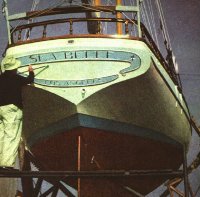 |
| This photo, showing the transom of the Sea Belle, is one of my favorites. It shows the exquisitely graceful transom of the Sea Witch – in my opinion, one of the most beautiful transoms ever designed. |
As mentioned above, in August of 2006, this web site began producing some results on the search for lines of the Sea Witch. Jan Peters, of the Sea Mist, offhandedly asked in a email whether I would be interested in a copy of the lines of Sea Witch. "Indeed, I would!" I answered. It seemed my prayer for plans was about to be answered. And so it came to pass that Jan, in October, sent me a lines drawing she and her husband Dave had acquired with their boat. Sea Mist, of course, is one of the most beautiful Sea Witches ever built.
The drawing is apparently the work of someone at the Jensen Boatyard in Denmark, where Sea Mist was built. The drawing is not a tracing, and the layout and information included is not in the standard American yacht design tradition. There are no marks, remarks, or signatures on the drawing to identify the draftsman. Though it isn't an actual copy of an Angelman/Davies original, and some inaccuracies are evident in the drawing, it's good enough to produce a table of offsets that would pretty near duplicate a "modern" Sea Witch hull – or a Sea Mist hull, if there are deviations from the original.
|
LINES OF THE SEA MIST |
| This is a very rough representation of the lines of Sea Mist as received from Jan Peters. This doesn't do the drawing aesthetic justice, of course, since I had to scan them piecemeal and cut and paste them together like a jigsaw puzzle for this illustration. |
Below I've redrawn the lines of the Sea Mist, and it is probably a pretty close approximation of the hull form built in Hong Kong by American Marine and Cheoy Lee.
|
|
|
Approximate Sea Witch lines based on the builder's drawing of Sea Mist lines. Buttock lines and some other details have been added. |
After receiving the Sea Mist lines, a copy of the Sea Witch - Sea Rover construction drawing (1945 plan), came out of the woodwork (compliments of Greg Jordan, and George Hylkema). Then came an almost complete set of offsets for the same plan (compliments of Robby Coleman). These permitted me to reconstruct a pretty accurate facsimile of the lines of the post 1937, pre-1956, Sea Witch. This is shown below for comparison with the Sea Mist lines above. The major differences, of course, are in the keel and rabbet line profile, and the bow. The 1937 lines and 1945 plans were of a 35 foot, bluff bowed, Sea Witch, and the "modern" Sea Witch is closer to 36 feet length on deck.
In February of 2010 the big break break came thanks to Roger Marlin, a former owner of the Golden Hind. In addition to many nice photos of the Golden Hind during her golden years, Roger sent us images of seven plan sheets dated 1956. They include the lines and table of offsets to what appears to be the final Sea Witch hull configuration. These lines are shown below.
|
|
| Genuine WILBO lines drawing contributed by Roger Marlin, former owner of the Golden Hind. There are seven sheets in all which can be viewed on the Sea Witch Plans Page. |
We've come a long way in the search for the plans of the Sea Witch, and resolved some perplexing issues, and though we do not yet have a complete set of plans, we finally have some images of the the genuine real McCoy in the realm of lines and offsets which would permit a capable builder to duplicate the Sea Witch. To see all we've been able to assemble see the Sea Witch Plans Page.
Please send any information to: webmaster@heritech.com
| This web site may contain copyrighted material not specifically authorized by the copyright owner. Such material is made available on a nonprofit basis for educational and general interest purposes – in in the interests of disseminating information on the Sea Witch. It is believed this constitutes "fair use" under section 107 of the US Copyright Law. For more information see: www.law.cornell.edu/uscode/17/107.shtml. |